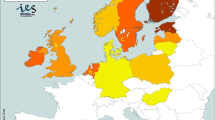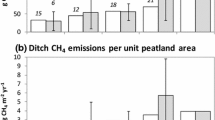Abstract
Using data from a single upland peat catchment (North Pennines, UK), this study combines descriptions of the uptake of carbon by primary productivity and input from both wet and dry deposition with descriptions of carbon release pathways: soil CO2 respiration, CH4 flux, particulate organic carbon (POC), dissolved organic carbon (DOC), and excess dissolved CO2. Each pathway is projected 10 years into the future based upon extrapolated changes in rainfall and temperature. The study shows that the catchment is presently a net source of carbon and that over a period of 10 years the catchment goes from a net source of 11.2 to 20.9 gC/m2/year. The probability that the catchment is a net sink of carbon decreases from 35 to 26% over the study period, i.e. upland peats are predicted to become an increasing source of carbon. With respect to carbon gases (CO2 + CH4), the catchment remains a net sink but this decreases from 15.9 to 11.2 gC/m2/year, given current trends the catchment will become a net source of carbon gases by 2034. For most pathways the predicted increases or decreases are in line with increasing temperature predicted for the area, but DOC flux shows a larger percentage increase because of additional production caused by the increased frequency of severe droughts within the catchment. If this result is extended across the UK uplands, peats would be a net source of between 0.26 and 0.45 Mt C/year, but with respect to carbon gases alone the catchment is net sink of between 0.35 and 0.23 Mt C/year.
Similar content being viewed by others
References
Archer D, Stewart D (1995) The installation and use of a snow pillow to monitor snow water equivalent. J Chartered Inst Water & Environ Manage 9:221–230
Beswick KM, Simpson TW, Fowler D, Choularton TW, Gallagher MW, Hargreaves KJ, Sutton MA, Kaye A (1998) Methane emissions on large scales. Atmos Environ 32:3283–3291
Bouchard A (1997) Recent lake acidification and recovery trends in southern Quebec, Canada. Water Air Soil Pollut 94:225–245
Bubier J, Costello A, Moore TR, Roulet NT, Savage K (1993) Microtopography and methane flux in boreal peatlands, Northern Ontario, Canada. Can J Bot 71:1056–1063
Burt TP, Adamson JK, Lane AMJ (1998) Long-term rainfall and streamflow records for north central England: putting the Environmental Change Network site at Moor House, Upper Teesdale, in context. Hydrol Sci J 43:775–787
Carling PA (1983) Particulate dynamics, dissolved and total load, in two small basins, North Pennines, UK. Hydrol Sci J 28:355–375
Cannell MGR, Dewar RC, Pyatt DG (1993) ‘Conifer plantations on drained peatlands in Britain: a net gain or loss of carbon? Forestry 66:353–369
Cannell MGR, Milne R, Hargreaves KJ, Brown TAW, Cruickshank MM, Bradley RI, Spencer T, Hope D, Billett MF, Adger WN, Subak S (1999) National inventories of terrestrial carbon sources and sinks: the UK experience. Clim Change 42:505–538
Chapman SB (1979) Some interrelationships between soil and root respiration in lowland Calluna heathland, southern England. J Ecol 67:1–20
Chapman SJ, Thurlow M (1996) The influence of climate on CO2 and CH4 emissions from organic soils. Agric For Meteorol 7:205–217
Choularton TW, Gallagher MW, Bower KN, Fowler D, Zahniser M, Kaye A (1995) Trace gas flux measurements at the landscape scale using boiundary layer budgets. Philos Trans R Soc A 351:357–369
Clark JM, Chapman PJ, Adamson JK, Lane SJ (2005) Influence of drought-induced acidification on the mobility of dissolved organic carbon in peat soils. Glob Chang Biol 11:791–809
Clymo RS, Pearce DME (1995) Methane and carbon dioxide production in, transport through, and efflux from a peatland. Philos Trans R Soc A 350:249–259
Crisp DT, Howson G (1982) ‘Effect of air temperature upon mean water temperature in streams in the north Pennines and English Lake District. Freshw Biol 12:359–367
Cui JB, Li CS, Trettin C (2005) Analysing the ecosystem carbon and hydrologic characteristics of forested wetland using a biogeochemical process model. Glob Chang Biol 11(2):278–289
Daulet WE, Clymo RS (1998) Effects of temperature and water table on the efflux of methane from peatland surface cores. Atmos Environ 32:3207–3218
Dawson JC, Billet MF, Neal C, Hill S (2002) A comparison of particulate, dissolved and gaseous carbon in two contrasting upland streams in the UK. J Hydrol 257:226–246
Evans CD, Montieth DT (2001) Chemical trends at lakes and streams in the UK Acid Waters Monitoring Network, 1988–2000: evidence for recent recovery at a national scale. Hydrol Earth Syst Sci 5:351–366
Evans MG, Burt TP, Holden J, Adamson JK (1999) Runoff generation and water table fluctuations in blanket peat: evidence from UK data spanning the dry summer of 1995. J Hydrol 221:141–160
Evans M, Warburton J, Yang J (2006) Eroding blanket pest catchments: global and local implications of upland organic sediment budgets. Geomorphology 79:45–57
Fowler D, Hargreaves KJ, Skiba U, Milne R, Zahniser MS, Moncrieff JB, Beverland IJ, Gallagher MW (1995) Measurements of CH4 and N2O fluxes at the landscape scale using micrometeorological methods. Philos Trans R Soc A 351:339–356
Francis IS, Taylor JA (1989) The effect of forestry drainage operations on upland sediment yields: a study of two peat covered catchments. Earth Surf Process Landf 14:73–83
Freeman C, Evans CD, Montieth DT, Reynolds B, Fenner N (2001a) Export of organic carbon from peat soils. Nature 412:785–786
Freeman C, Ostle N, Kang H (2001b) An enzymic ‘latch’ on a global carbon store—a shortage of oxygen locks up carbon in peatlands by restraining a single enzyme. Nature 409:149
Freeman C, Fenner N, Ostle NJ, Kang H, Dowrick DJ, Reynolds B, Lock MA, Sleep D, Hughes S, Hudson J (2004) Export of dissolved organic carbon from peatlands under elevated carbon dioxide levels. Nature 430:195–198
Frolking S, Roulet NT, Moore TR, Lafleur PM, Bubier JL, Crill PM (2002) Modelling seasonal to annual carbon balance of Mer Bleue bog, Ontario, Canada. Glob Biogeochem Cycles 16, 3, art. No. 1030
Gallagher MW, Choularton TW, Bower KN, Stromberg IM, Beswick KM, Fowler D, Hargreaves KJ (1994) Measurements of methane fluxes on the landscape scale from a wetland area in North Scotland. Atmos Environ 28:2421–2430
Garnett MH (1998) Carbon storage in Pennine moorland and response to change’. Unpublished PhD thesis, University of Newcastle upon Tyne
Greive IC (1990a) Variations in the chemical composition of the soil solution over a four year period at an upland site in southwest Scotland. Geoderma 46:351–362
Greive IC (1990b) Soil and soil solution chemical composition at three sites within the Loch Dee catchment, SW Scotland. J Soil Sci 41:269–277
Hargreaves KJ, Fowler D (1998) Quantifying the effects of water table and soil temperature on the emission of methane from peat wetland at the field scale. Atmos Environ 32:3275–3282
Harriman R, Curtis C, Edwards AC (1998) An empirical approach for assessing the relationship between nitrogen deposition and nitrate leaching from upland catchments in the United Kingdom using runoff chemistry. Water Air Soil Pollut 105:193–203
Hirsch RM, Slack JR, Smith RA (1982) Techniques of trend analysis for monthly water quality data. Water Resour Res 18:107–121
Hope D, Palmer SM, Billet MF, Dawson JC (2001) Carbon dioxide and methane oxidation evasion from a temperate peatland stream. Limnol Oceanogr 46:847–857
Hughes S, Dowrick DJ, Freeman C, Hudson JA, Reynolds B (1999) Methane emissions from a gully mire in mid-Wales, UK under consecutive summer water table drawdown. Environ Sci Tech 33:362–365
Johnson GAL, Dunham K (1963) The geology of Moor House. Nature Conservancy Council, HMSO, London
Jones JB, Mulholland PJ (1998) Carbon dioxide variation in a hardwood forest stream: an integrative measure of whole catchment soil respiration. Ecosystems 1:183–196
Krug EC, Frink CR (1983) Acid rain on acid soil: a new perspective. Science 211:520–525
Kullberg A, Petersen RC (1987) Dissolved organic carbon, seston and macroinvertebrate drift in an acidified and limed humic stream. Freshw Biol 17:553–564
Leith H (1975) Modeling the primary production of the world. In: Leith H, Whittaker RH (eds) Primary production of the biosphere. Springer-Verlag, New York, pp 237–262
Lloyd J, Taylor JA (1994) On the temperature dependence of soil respiration. Funct Ecol 8:315–323
Lloyd D, Thomas KL, Benstead J, Davies KL, Lloyd SH, Arah JRM, Stephen KD (1998) Methanogenesis and CO2 exchange in an ombrotrophic peat bog. Atmos Environ 32:3229–3238
MacDonald JA, Skiba U, Sheppard IJ, Hargreaves KJ, Smith KA, Fowler D (1996) Soil environment variables affecting the flux of methane from a range of forest, moorland and agricultural soils. Biogeochemistry 34:113–132
MacDonald JA, Fowler D, Hargreaves KJ, Skiba U, Leith ID, Murray MB (1998) Methane emission rates from a northern wetland; response to temperature, water table and transport. Atmos Environ 32:3219–3227
Milne R, Brown TA (1997) Carbon in the vegetation and soils of Great Britain. J Environ Manag 49:413–433
Neal C, House WA, Down K (1998) An assessment of excess carbon dioxide partial pressure in natural waters based on pH and alkalinity measurements. Sci Total Environ 210/211:173–185
Reich JW, Schlesinger WH (1992) The global carbon dioxide flux in soil respiration and its relationship to climate. Tellus 44b:81–99
Rivers JS, Siegel DI, Chasar LS, Chanton JP, Glaser PH, Roulet NT, McKenzie JM (1998) A stochastic appraisal of the annual carbon budget of a large circumboreal peatland, Rapid River watershed, northern Minnesota. Glob Biogeochem Cycles 12:715–727
Silvola K, Valijokki J, Aaltonen H (1985) Effect of training and fertilisation on soil respiration at three ameliorated peatland sites. Acta For Fenn 191:1–32
Skjelkvåle BL, Mannio J, Wilander A, Andersen T (2001) Recovery from acidification of lakes in Finland, Norway and Sweden 1990–1999. Hydrol Earth Syst Science 5:327–338
Svensson B (1980) Carbon dioxide and methane fluxes from the ombrotrophic parts of a subartic mire. Ecol Bull 30:235–350
Sykes JM, Lane AMJ (1996) The United Kingdom Environmental Change Network: protocols for standard measurements of terrestrial sites. Natural Environment Research Council, London, pp 220
Tallis JH, Meade R (1998) Blanket mire degradation and management. In: Tallis JH, Meade R, Hulme PD (eds) Blanket mire degradation: causes, challenges and consequences. Macauley Land Use Research Institute, Aberdeen, pp 212–216
Tranvik LJ, Jansson M (2002) Terrestrial export of organic carbon. Nature 415:861–862
Worrall F, Burt TP (1998) Decomposition of river water nitrate time series—comparing the agricultural and urban signals. Sci Total Environ 210/211:153–162
Worrall F, Burt TP (1999) A univariate model of river water nitrate time series. J Hydrol 214:74–90
Worrall F, Burt TP (2004a) Time series analysis of long term river DOC records. Hydrol Process 18:893–911
Worrall F, Burt TP (2004b) Reconstructing long-term records of dissolved CO2. Hydrol Process 19:1791–1806
Worrall F, Reed M, Warburton J, Burt TP (2003a) Carbon budget for British upland peat catchment. Sci Total Environ 312:133–146
Worrall F, Burt TP, Shedden R (2003b) Long terms records of riverine carbon flux. Biogeochemistry 64:165–178
Worrall F, Burt TP, Adamson J (2004a) Can climate change explain increases in DOC flux from upland peat catchments? Sci Total Environ 326:95–112
Worrall F, Harriman R, Evans CD, Watts C, Adamson JK, Neal C, Tipping E, Burt TP, Grieve I, Montieth D, Naden PS, Reynolds B, Stevens P (2004b) Trends in dissolved organic carbon in UK rivers and lakes. Biogeochemistry 70:369–402
Worrall F, Burt TP, Adamson JK (2005a) Fluxes of dissolved carbon dioxide and inorganic carbon from an upland peat catchment: implications for soil respiration. Biogeochemistry 73:515–539
Worrall F, Burt TP, Adamson JK (2005b) Predicting the future DOC flux form upland peat catchments. J Hydrol 300:126–139
Worrall F, Burt TP, Adamson J (2007) Modelling the future flux of dissolved carbon dioxide from an upland peat catchment Hydrol Process (in press)
Author information
Authors and Affiliations
Corresponding author
Rights and permissions
About this article
Cite this article
Worrall, F., Burt, T., Adamson, J. et al. Predicting the future carbon budget of an upland peat catchment. Climatic Change 85, 139–158 (2007). https://doi.org/10.1007/s10584-007-9300-1
Received:
Accepted:
Published:
Issue Date:
DOI: https://doi.org/10.1007/s10584-007-9300-1




